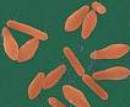The Centers for Disease Control and Prevention (CDC) is offering home canners tips to keep the food they prepare safe from botulism. While home canning is a great way to preserve produce from your garden, you need to follow specific food safety rules so the food you prepare doesn’t make someone sick. If foods, especially low-acid foods such as vegetables, are improperly sealed or are not heated to a high enough temperature to kill the spores while processing, the bacteria will grow in the food and produce the toxin.
 Clostridium botulinum, the bacteria that causes botulism poisoning, is a very hardy bacteria that is found in garden soil. It grows under anaerobic, low-acid conditions (without oxygen), so food sealed in cans is its preferred growth medium. It produces botulism toxin, a potent nerve agent that can paralyze and cause death. Symptoms of botulism poisoning include double vision, blurred vision, slurred speech, difficulty swallowing, dry, mouth, muscle weakness, and difficulty breathing. Symptoms usually appear 18 to 36 hours after eating contaminated food, but they can occur as early as 6 hours or as late as 10 days after exposure.
Clostridium botulinum, the bacteria that causes botulism poisoning, is a very hardy bacteria that is found in garden soil. It grows under anaerobic, low-acid conditions (without oxygen), so food sealed in cans is its preferred growth medium. It produces botulism toxin, a potent nerve agent that can paralyze and cause death. Symptoms of botulism poisoning include double vision, blurred vision, slurred speech, difficulty swallowing, dry, mouth, muscle weakness, and difficulty breathing. Symptoms usually appear 18 to 36 hours after eating contaminated food, but they can occur as early as 6 hours or as late as 10 days after exposure.
The bacteria and the toxin it produces does not necessarily change the taste, texture, smell, or appearance of food. Home canned vegetables are the most common cause of botulism outbreaks in the U.S., although cases have been caused by garlic stored in oil, baked potatoes cooked and stored in foil, and foods prepared sous vide (sealed in plastic and poached).
Food safety experts recommend that non-acidic foods such as green beans, corn, soups, and meat must be processed in a pressure canner, not a boiling water bath. The pressure canner can raise the temperature of the food to 240 degrees F, which is hot enough to kill botulism spores. High acid foods, such as pickled produce, jellies, jams, and fruit can be safely processed in a boiling water bath. To be perfectly safe, low acid home-canned foods should be boiled for 10 minutes before eating.
Make sure you examine the jars of home canned food (and any canned food, for that matter) before you eat it. If the container is leaking, bulging, or swollen, throw it out. Discard it if the container is damaged, cracked, or abnormal in any way. If the can or jar spurts liquid or foam when opened, throw it away. Finally, if the food is discolored, moldy, or has a bad smell, get rid of it. Never taste home-canned food to see if it’s safe. And if any suspect food spills, clean the spill with a diluted bleach solution of 1/4 cup bleach to 2 cups of water.




